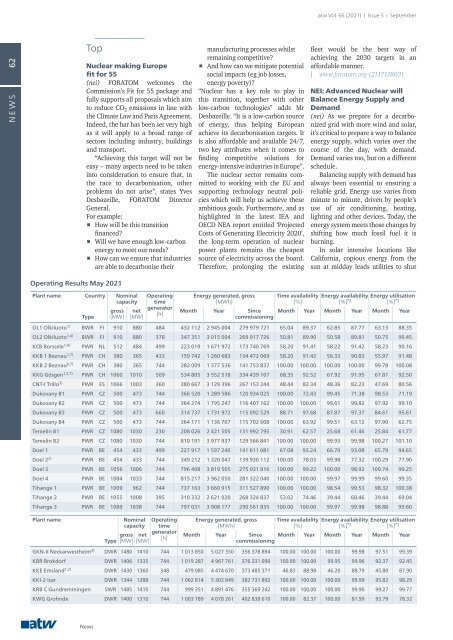atw - International Journal for Nuclear Power | 05.2021
Description Ever since its first issue in 1956, the atw – International Journal for Nuclear Power has been a publisher of specialist articles, background reports, interviews and news about developments and trends from all important sectors of nuclear energy, nuclear technology and the energy industry. Internationally current and competent, the professional journal atw is a valuable source of information. www.nucmag.com
Description
Ever since its first issue in 1956, the atw – International Journal for Nuclear Power has been a publisher of specialist articles, background reports, interviews and news about developments and trends from all important sectors of nuclear energy, nuclear technology and the energy industry. Internationally current and competent, the professional journal atw is a valuable source of information.
www.nucmag.com
Create successful ePaper yourself
Turn your PDF publications into a flip-book with our unique Google optimized e-Paper software.
<strong>atw</strong> Vol. 66 (2021) | Issue 5 ı September<br />
62<br />
NEWS<br />
Top<br />
<strong>Nuclear</strong> making Europe<br />
fit <strong>for</strong> 55<br />
(nei) FORATOM welcomes the<br />
Commission’s Fit <strong>for</strong> 55 package and<br />
fully supports all proposals which aim<br />
to reduce CO 2 emissions in line with<br />
the Climate Law and Paris Agreement.<br />
Indeed, the bar has been set very high<br />
as it will apply to a broad range of<br />
sectors including industry, buildings<br />
and transport.<br />
“Achieving this target will not be<br />
easy – many aspects need to be taken<br />
into consideration to ensure that, in<br />
the race to decarbonisation, other<br />
problems do not arise”, states Yves<br />
Desbazeille, FORATOM Director<br />
General.<br />
For example:<br />
p How will be this transition<br />
financed?<br />
p Will we have enough low-carbon<br />
energy to meet our needs?<br />
p How can we ensure that industries<br />
are able to decarbonise their<br />
manufacturing processes whilst<br />
remaining competitive?<br />
p And how can we mitigate potential<br />
social impacts (eg job losses,<br />
energy poverty)?<br />
“<strong>Nuclear</strong> has a key role to play in<br />
this transition, together with other<br />
low- carbon technologies” adds Mr<br />
Desbazeille. “It is a low-carbon source<br />
of energy, thus helping European<br />
achieve its decarbonisation targets. It<br />
is also af<strong>for</strong>dable and available 24/7,<br />
two key attributes when it comes to<br />
finding competitive solutions <strong>for</strong><br />
energy-intensive industries in Europe”.<br />
The nuclear sector remains committed<br />
to working with the EU and<br />
supporting technology neutral policies<br />
which will help us achieve these<br />
ambitious goals. Furthermore, and as<br />
highlighted in the latest IEA and<br />
OECD NEA report entitled ‘Projected<br />
Costs of Generating Electricity 2020’,<br />
the long-term operation of nuclear<br />
power plants remains the cheapest<br />
source of electricity across the board.<br />
There<strong>for</strong>e, prolonging the existing<br />
fleet would be the best way of<br />
achieving the 2030 targets in an<br />
af<strong>for</strong>dable manner.<br />
| www.<strong>for</strong>atom.org (211711803)<br />
NEI: Advanced <strong>Nuclear</strong> will<br />
Balance Energy Supply and<br />
Demand<br />
(nei) As we prepare <strong>for</strong> a decarbonized<br />
grid with more wind and solar,<br />
it’s critical to prepare a way to balance<br />
energy supply, which varies over the<br />
course of the day, with demand.<br />
Demand varies too, but on a different<br />
schedule.<br />
Balancing supply with demand has<br />
always been essential to ensuring a<br />
reliable grid. Energy use varies from<br />
minute to minute, driven by people’s<br />
use of air conditioning, heating,<br />
lighting and other devices. Today, the<br />
energy system meets those changes by<br />
shifting how much fossil fuel it is<br />
burning.<br />
In solar intensive locations like<br />
Cali<strong>for</strong>nia, copious energy from the<br />
sun at midday leads utilities to shut<br />
Operating Results May 2021<br />
Plant name Country Nominal<br />
capacity<br />
Type<br />
gross<br />
[MW]<br />
net<br />
[MW]<br />
Operating<br />
time<br />
generator<br />
[h]<br />
Energy generated, gross<br />
[MWh]<br />
Month Year Since<br />
commissioning<br />
Time availability<br />
[%]<br />
Energy availability<br />
[%] *) Energy utilisation<br />
[%] *)<br />
Month Year Month Year Month Year<br />
OL1 Olkiluoto 1) BWR FI 910 880 484 432 112 2 945 004 279 979 721 65.04 89.37 62.85 87.77 63.13 88.35<br />
OL2 Olkiluoto 1,4) BWR FI 910 880 378 347 351 3 015 004 269 917 726 50.81 89.90 50.58 89.81 50.75 90.45<br />
KCB Borssele 1,4) PWR NL 512 484 499 223 019 1 671 972 173 740 769 58.20 91.41 58.22 91.42 58.23 90.16<br />
KKB 1 Beznau 1,7) PWR CH 380 365 433 159 742 1 260 683 134 472 069 58.20 91.42 56.33 90.83 55.97 91.48<br />
KKB 2 Beznau 6,7) PWR CH 380 365 744 282 009 1 377 536 141 753 837 100.00 100.00 100.00 100.00 99.78 100.08<br />
KKG Gösgen 1,2,7) PWR CH 1060 1010 509 534 805 3 552 518 334 439 107 68.35 92.52 67.92 91.95 67.81 92.50<br />
CNT-I Trillo 3) PWR ES 1066 1003 360 380 667 3 129 396 267 153 244 48.44 82.34 48.36 82.23 47.69 80.56<br />
Dukovany B1 PWR CZ 500 473 744 366 520 1 289 586 120 934 025 100.00 72.43 99.45 71.38 98.53 71.19<br />
Dukovany B2 PWR CZ 500 473 744 364 274 1 795 247 116 407 162 100.00 100.00 99.61 99.82 97.92 99.10<br />
Dukovany B3 PWR CZ 500 473 660 314 737 1 731 972 115 092 529 88.71 97.68 87.87 97.37 84.61 95.61<br />
Dukovany B4 PWR CZ 500 473 744 364 171 1 136 707 115 702 608 100.00 63.92 99.51 63.12 97.90 62.75<br />
Temelin B1 PWR CZ 1080 1030 230 208 026 2 421 505 131 992 795 30.91 62.57 25.68 61.46 25.84 61.77<br />
Temelin B2 PWR CZ 1080 1030 744 810 191 3 977 937 129 566 841 100.00 100.00 99.93 99.98 100.27 101.10<br />
Doel 1 PWR BE 454 433 499 227 917 1 597 240 141 611 081 67.08 93.24 66.70 93.08 65.79 94.65<br />
Doel 2 2) PWR BE 454 433 744 349 212 1 320 047 139 930 112 100.00 78.03 99.98 77.32 100.29 77.90<br />
Doel 3 PWR BE 1056 1006 744 796 408 3 819 505 275 031 816 100.00 99.22 100.00 98.92 100.74 99.25<br />
Doel 4 PWR BE 1084 1033 744 815 217 3 962 050 281 322 040 100.00 100.00 99.97 99.99 99.60 99.35<br />
Tihange 1 PWR BE 1009 962 744 737 163 3 660 915 311 527 890 100.00 100.00 98.54 99.53 98.32 100.38<br />
Tihange 2 PWR BE 1055 1008 395 310 332 2 621 020 268 324 837 53.02 74.46 39.44 68.46 39.44 69.04<br />
Tihange 3 PWR BE 1089 1038 744 797 031 3 908 177 290 561 835 100.00 100.00 99.97 99.98 98.88 99.60<br />
Plant name<br />
Type<br />
Nominal<br />
capacity<br />
gross<br />
[MW]<br />
net<br />
[MW]<br />
Operating<br />
time<br />
generator<br />
[h]<br />
Energy generated, gross<br />
[MWh]<br />
Time availability<br />
[%]<br />
Energy availability Energy utilisation<br />
[%] *) [%] *)<br />
Month Year Since Month Year Month Year Month Year<br />
commissioning<br />
GKN-II Neckarwestheim 4) DWR 1480 1410 744 1 013 850 5 027 350 356 378 894 100.00 100.00 100.00 99.98 97.51 99.39<br />
KBR Brokdorf DWR 1406 1335 744 1 019 287 4 967 761 376 231 090 100.00 100.00 99.95 99.96 92.37 92.45<br />
KKE Emsland 1,2) DWR 1430 1360 348 479 085 4 474 670 373 485 371 46.83 88.98 46.20 88.79 45.80 87.90<br />
KKI-2 Isar DWR 1344 1288 744 1 062 814 5 302 849 382 731 892 100.00 100.00 100.00 99.99 95.82 98.29<br />
KRB C Gundremmingen SWR 1485 1410 744 999 351 4 891 476 355 369 242 100.00 100.00 100.00 99.90 99.27 99.77<br />
KWG Grohnde DWR 1400 1310 744 1 003 789 4 078 261 402 838 610 100.00 82.37 100.00 81.99 93.79 78.32<br />
News

















